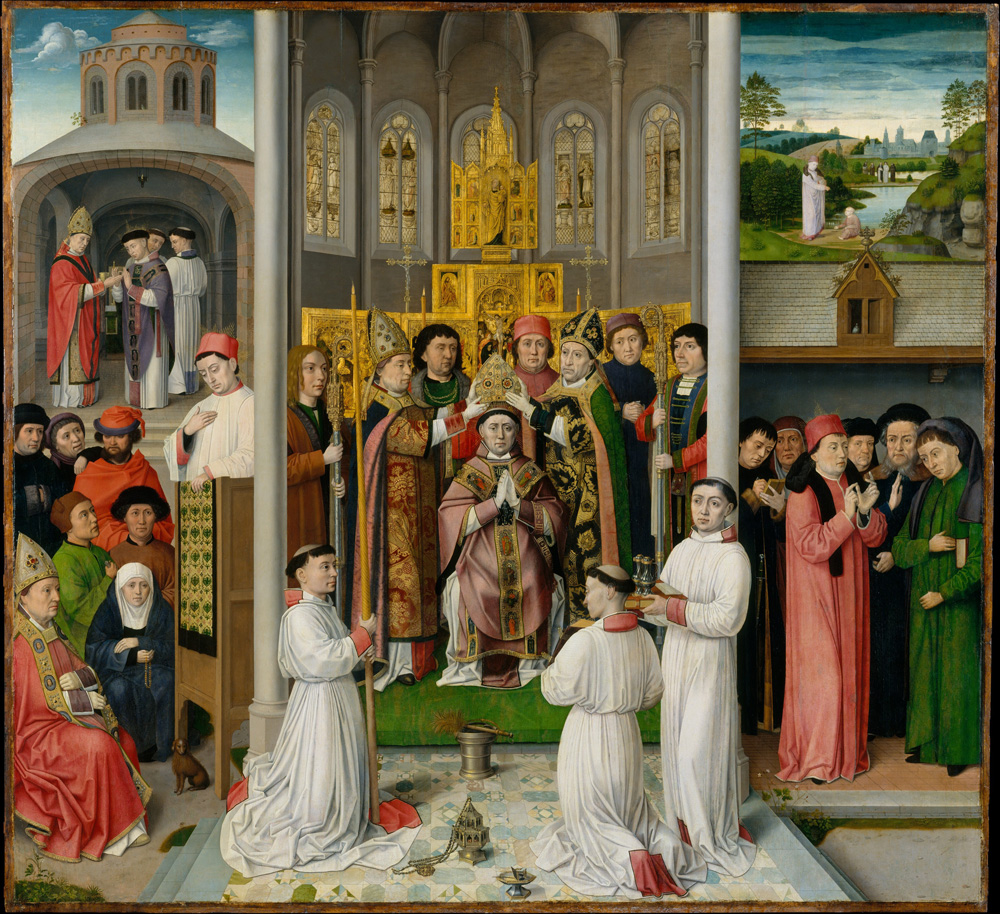Master of St. Augustine, The St. Augustine Altarpiece

Bruges, Circa 1490
Oil, gilding, and silver on oak panel, 54 1/4 x 59 in. (137.8
x 149.9 cm)
The Cloisters, New York City (accession number 61-199)
This is the central panel of a triptych. It echoes the typical organization of triptychs by putting the large central scene between two painted "columns" and populating the sides with four scenes from the saint's life. Further visual trickery in the sides unifies separate scenes: On the left, Augustine preaches in the open air before the church where he is being ordained a priest. On the right, he teaches about the Trinity while a boy in the background explains that it is incomprehensible.
In the scene on the upper left Bishop Valerius of Hippo ordains Augustine as a priest. (At the moment shown he is anointing Augustine's hands.) Below left, Augustine preaches in Hippo while Valerius and his mother St. Monica listen. According to the Golden Legend, Valerius' mother tongue was Greek and he needed Augustine to preach to the people in Latin. At Valerius' left is St. Monica, Augustine's mother. This is an anachronism, because Monica died before Augustine returned to Africa from Milan, but then so is her rosary.
In the central scene Valerius and another bishop consecrate Augustine as Bishop of Hippo. The three men in white are minor clergy charged with various sacred items associated with baptism: a tall candle, an aspergillum (used at solemn masses for sprinkling the congregation as a symbol of their baptism), a censer, a box for salt (a symbol of preservation from sin to be placed in the baptized person's mouth), and the two ampullae of chrism or blessed oil. The middle man holds the book from which the celebrant will read parts of the liturgy.
On the right Augustine teaches a group of men about the Trinity, counting off the number three on his fingers. Ironically, the upper right depicts the "Parable of the Trinity," in which a boy tells the saint the Trinity cannot fit into a man's head any more than the ocean could fit into the boy's little sand pail.
For other examples of the finger-counting gesture to denote religious instruction, see this page. In some other medieval and Renaissance images the fact that a saint is preaching can be denoted by his or her counting on fingers. This is how St. Catherine's address to the pagan philosophers is pictured in Pinturicchio's 1492 Disputation of St. Catherine (McDowell, 170) and Cenni's
St. Catherine Disputing with the Philosophers. We also see the gesture in Jan Polack's
St. Peter as Teacher and in Giralte de Bruselas's sclpture group of the
Boy Jesus among the Doctors. The same signifier is used even for the true and false
interpretings of Nebuchadnezzar's dream. In Master Francke's
St. Barbara Altar
the saint counts on her fingers as she tries to explain the Christian faith to her father. In Bonaiuto's
The Church Militant and The Church Triumphant St. Peter of Verona counts on his fingers as he addresses an unreceptive crowd of heretics.
View this image in full resolution.
Read more about images of St. Augustine and St. Monica.
Read more about medieval and Renaissance altarpieces.
Photographed at The Cloisters by Richard Stracke, shared under Attribution-NonCommercial-ShareAlike license.